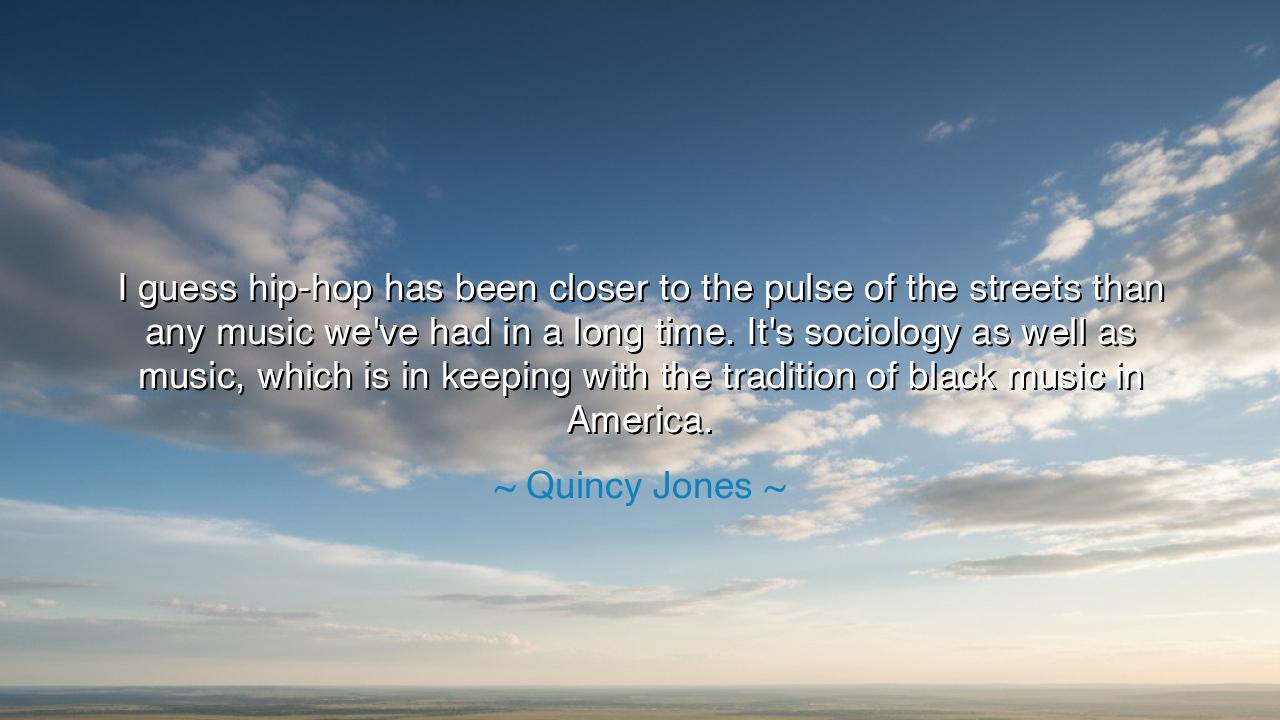
I guess hip-hop has been closer to the pulse of the streets than
I guess hip-hop has been closer to the pulse of the streets than any music we've had in a long time. It's sociology as well as music, which is in keeping with the tradition of black music in America.






Hear the words of Quincy Jones, master of sound and keeper of rhythm, who declared: “I guess hip-hop has been closer to the pulse of the streets than any music we’ve had in a long time. It’s sociology as well as music, which is in keeping with the tradition of black music in America.” These words are not merely observation, but revelation. For in them lies the recognition that music is more than melody, more than entertainment—it is the heartbeat of a people, the chronicle of their struggle, their joy, their pain, their hope.
When Quincy speaks of hip-hop, he names it not only as a genre but as a living document, a scripture written in beats and rhymes. It is the sound of the streets, the testimony of those whom society often silenced. It is the cry of the oppressed, the wisdom of the hustler, the laughter of survival, the poetry of resilience. To call it sociology as well as music is to declare that hip-hop is both art and truth: a mirror held up to the world, showing poverty, racism, violence, but also creativity, brotherhood, and unbreakable spirit.
This is not a new tradition but an ancient one. From the sorrow songs of the enslaved to the spirituals of the church, from the blues born in the Mississippi Delta to the jazz of Harlem’s renaissance, black music in America has always carried the dual weight of art and sociology. It has always been more than sound—it has been testimony. Every note bore history, every lyric carried truth. Hip-hop, Quincy reminds us, is the inheritor of this mantle, the modern vessel for the ancient rhythm of survival and expression.
Consider the story of Grandmaster Flash and the Furious Five, whose song The Message in 1982 shattered illusions. With its words—“Don’t push me ‘cause I’m close to the edge”—it painted the picture of urban decay, of life in the ghettos, of struggles invisible to many but all too real to those who lived them. It was not simply a song; it was sociology set to rhythm, a history lesson in rhyme. It carried more truth about the streets than a thousand speeches. This is the essence Quincy speaks of: art as the voice of reality.
And recall, too, Billie Holiday’s haunting Strange Fruit, sung decades before. With her voice, she bore witness to the horrors of lynching in America. It was not entertainment—it was a dagger of truth, cloaked in melody. Her music was sociology, just as hip-hop is, carrying forward the same tradition that Quincy honors: the truth of black life sung to the world.
The lesson is clear: do not think of music only as pleasure for the ear. See it as a teacher, a prophet, a witness. For in the rhythm of the oppressed lies the wisdom of survival, and in their songs lies the history that books may neglect. To dismiss hip-hop or blues or jazz as “mere music” is to close one’s eyes to the testimony of generations. Music is memory, resistance, and vision for what could yet be.
And what must you do, O listener? Open your ears not only to the melody but to the message. When you hear a song born of the streets, ask: what truth does it reveal? When you hear the rhythm of struggle, let it teach you empathy. Support the voices that rise from the margins, for they are the heartbeat of society. And in your own life, let your art—whatever form it takes—speak truth as well as beauty.
Thus, let us carry Quincy Jones’ wisdom as a torch: hip-hop is not just music—it is sociology, testimony, and tradition. Honor the music of the people, for in it lies the story of who we are, and who we may yet become.






AAdministratorAdministrator
Welcome, honored guests. Please leave a comment, we will respond soon